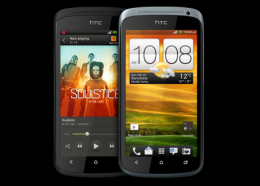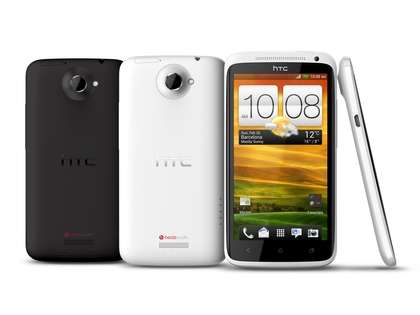Review: New HTC phones are Ones to look for

When it comes to smartphones, I'm an iPhone guy. But I've long appreciated HTC's Android phones.
The first Android phone I really liked was the Google Nexus One, which was made by HTC. I also was a big fan of the Nexus One's sibling, the Droid Incredible.
But in the past year or so, HTC has struggled to make phones that stood out in the increasingly crowded Android marketplace. It has lost share to Samsung, which has focused on phones with jumbo, brilliantly lit screens.
Now HTC is trying to stage a comeback. Earlier this year, it announced a new flagship line of phones dubbed One. The first two models in the line, the One S and the One X, recently hit store shelves at T-Mobile and AT&T, respectively.
I've been testing out both phones and generally like what I've seen. I don't consider either one a must-have, but they are both worth a serious look if you are in the market for an Android device.
Of the two, I was immediately drawn to the One S. I've not been a big fan of phones with screens larger than 4 inches because they tend to be unwieldy to use with one hand. But the One S is super-sleek.
Despite having the same 4.3-inch screen as Motorola's Droid Razr, the One S is lighter. It's also nearly as thin as the Razr without having a raised bump for its camera. Instead, the One S's back is flat with rounded edges and feels great in the hand.
With a 4.7-inch screen, the One X is noticeably bigger than the One S. Although it shares the same basic design and is only slightly heavier, its bulk makes it feel clumsy in my hands.
The two phones' screens differ not just in size but also in underlying technology and resolution. The One S has an organic light-emitting diode, or OLED, display, which offers richer colors and deeper blacks than the One X's LCD display, but looks a bit dimmer in bright light.
As one might expect from a bigger screen, the One X's shows more pixels than the One S's, but that's not necessarily a good thing. Some apps designed for smaller displays appear stretched out or have ultra-tiny buttons.
Still, the One S and the One X have a lot in common. Both have fast dual-core processors, an adequate but not ample amount of storage - 16 gigabytes-and the latest version of Android, which is known as Ice Cream Sandwich.
On both phones, though, HTC has decided to forgo the virtual system buttons that Google built into Ice Cream Sandwich, which change in number and appearance from application to application. Instead, HTC is sticking with the permanent and fixed touch-sensitive buttons that used to be found on all Android phones. I think that's a good choice; I've found the ever-changing system buttons in the latest version of Android to be confusing.
Both phones also run the latest version of HTC's Sense interface on top of Android. I've always liked Sense, an easier-to-use interface than what ships with the standard version of Android. HTC streamlined the interface a bit in the new version and added one cool feature that helps its devices continue to stand out from other Android phones.

Recently used applications are displayed as cards that are rotated slightly. You can swipe left and right to access various apps. And you can close applications by swiping up. It looks a lot like the multi-tasking system of Palm's webOS, which I loved, and I was happy to see HTC borrow the idea.
One of the key features HTC is touting in the One line of phones is their super-fast cameras.
I take a lot of pictures on cellphones, and it can be a really frustrating experience. They tend to do a poor job in low-light situations, and many are just too slow to capture pictures of fast-moving kids or animals.
But I was impressed with the cameras on the One phones, at least in terms of their speed. They shoot photos almost instantaneously. And if you keep the shutter button pressed down, they'll shoot continuously until you have no more storage space left - if you want to go that long. When you stop shooting, the phones will help you select the best shot; you can either keep all the ones you shot in a row, or simply the best one.
Neither phone is perfect. Thanks to its giant screen, the One X seemed to gobble up its battery power fairly quickly, even in moderate use.
Meanwhile, the One S suffers from its service provider; as I drove around the San Francisco Bay Area, I found numerous spots where I either couldn't get T-Mobile's service on the One S, or where I could only get its aging 2G network. The One S I tested also had a bug that caused it to mysteriously reboot several times, even when I wasn't using it.
---
HTC ONE S SMARTPHONE:
-Likes: Super-fast camera; sleek design; easy-to-use interface
-Dislikes: Spotty coverage; bug causes random reboots
-Specs: 1.5 GHz dual-core processor; 16 gigabytes of storage; 4.3-inch OLED screen; 8-megapixel rear and sub-1-megapixel front cameras
-Price: $200 with two-year T-Mobile contract
-Web: htc.com, t-mobile.com
---
HTC ONE X SMARTPHONE:
-Likes: Fast-shooting camera; easy-to-use interface; speedy 4G LTE coverage
-Dislikes: Bulky; big screen limits battery life; some apps appear stretched out on big screen
-Specs: 1.5 GHz dual-core processor; 16 gigabytes of storage; 4.7-inch LCD screen; 8-megapixel rear and sub-1-megapixel front cameras
-Price: $200 with two-year AT&T contract
-Web: www.htc.com, wireless.att.com
More information: Troy Wolverton is a technology columnist for the San Jose Mercury News.
(c)2012 the San Jose Mercury News (San Jose, Calif.)
Distributed by MCT Information Services





















